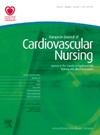因心脏病住院后持续护理方面的不平等
IF 2.9
3区 医学
Q2 CARDIAC & CARDIOVASCULAR SYSTEMS
引用次数: 0
摘要
背景 心脏病是全球住院治疗的常见原因。出院后仍需接受初级保健和/或专科护理的后续治疗。持续性护理对于实现住院后的无缝护理链至关重要。目前还缺乏有关出院后持续护理不平等的研究。目的 调查不同年龄、性别和诊断组别患者对持续性护理的看法有何不同。方法 连续纳入因心脏病住院后六周内的患者。采用简短版患者持续性护理问卷(PCCQ-12)收集数据。性别和年龄组(< 65 岁或 ≥ 65 岁)之间的差异比较采用独立 t 检验。诊断组之间的差异采用单因素方差分析(ANOVA)和事后分析,并进行最小显著性差异(LSD)校正。所有分析的显著性水平均定为 p &pamp;lt;0.05。结果 共纳入 1,000 名患者(平均年龄 72 岁(SD 10),66% 为男性)。患者因心肌梗死(36%)、心房颤动(26%)、心绞痛(21%)或心力衰竭(17%)住院。年龄、性别和诊断之间存在显著差异:65 岁以上患者对护理连续性的感知明显高于 65 岁以下患者。男性的得分明显高于女性。与因心绞痛、心房颤动或心力衰竭住院的患者相比,因急性心肌梗死住院的患者对护理连续性的感知水平明显更高(表 1)。男性和女性之间也存在显著差异。与年龄≥65 岁的男性(平均值为 45.51,P= 0.008)相比,年龄在 65 岁以上的男性(平均值为 48.08)对护理连续性的感知明显更高。与因心绞痛(平均值为 44.48)、心房颤动(平均值为 44.09)和心力衰竭(平均值为 45.24)住院的男性相比,因心肌梗死住院的男性在 PCCQ-12 中的得分明显更高(平均值为 48.82)(图 1)。与年龄≥65 岁的女性(平均值为 40.71,P 0.018)相比,年龄大于等于 65 岁的女性在 PCCQ-12 中的得分明显更高(平均值为 45.00)。因心肌梗塞或心房颤动住院的女性在 PCCQ-12 中的得分(平均值分别为 42.48 和 43.02)明显高于因心力衰竭住院的女性(平均值为 38.00)(图 1)。结论 总体而言,因心脏疾病住院的患者认为护理的连续性相当高。然而,男性和女性之间、年轻和年长患者之间以及诊断组别之间在统计学上存在明显差异,这表明在持续性护理方面存在护理不平等现象。本文章由计算机程序翻译,如有差异,请以英文原文为准。
Inequality in continuity of care after hospitalization due to cardiac conditions
Background Cardiac conditions are a common cause of hospitalization worldwide. The need for follow-up within primary care and/or specialized care continues after discharge. Continuity of care is crucial to enable a seamless chain of care after hospitalization. Research regarding inequality in continuity of care after discharge is lacking. Purpose The aim was to investigate how patients’ perceptions of continuity of care vary between age, gender, and diagnosis groups. Methods Patients were consecutively included within six weeks after hospitalization due to a cardiac condition. Data were collected with the short version of the Patient Continuity of Care Questionnaire (PCCQ-12). The independent t-test was used to compare differences between sexes and age groups (< 65 years or ≥ 65 years). Differences between diagnosis groups were evaluated with the one-way analysis of variance (ANOVA) and post-hoc analysis with the least significant difference (LSD) correction. The significance level was set at p <0.05 for all analyses. Results A total of 1,000 patients were included (mean age 72 years (SD 10) 66% male). The patients were hospitalized due to myocardial infarction (36%), atrial fibrillation (26%), angina pectoris (21%) or heart failure (17%). Significant differences between age, gender and diagnosis were found: Patients < 65 years perceived significantly higher levels of continuity of care than patients ≥ 65 years. Men had significantly higher scores than women. Patients hospitalized due to acute myocardial infarction perceived significantly higher levels of continuity of care compared to patients who had been hospitalized due to angina pectoris, atrial fibrillation, or heart failure (Table 1). Significant differences were also found between men and women. Men <65 years perceived significantly higher levels of continuity of care (mean 48.08) compared to men ≥ 65 years (mean 45.51, p= 0.008 ). Men who had been hospitalized due to myocardial infarction had significantly higher scores on the PCCQ-12 (mean 48.82) compared to men who had been hospitalized due to angina (mean 44.48), atrial fibrillation (mean 44.09) and heart failure (mean 45.24) (Figure 1). Women <65 years had significantly higher scores on the PCCQ-12 (mean 45.00) compared to women ≥ 65 years (mean 40.71, p 0.018). Women who had been hospitalized due to myocardial infarction or atrial fibrillation had significantly higher scores on the PCCQ-12 (mean 42.48 and 43.02, respectively) compared to women hospitalized due to heart failure (mean 38.00) (Figure 1). Conclusion Overall, patients hospitalized due to cardiac conditions perceive a rather high level of continuity of care. However, statistically significant differences were found between men and women, between younger and older patients, and between diagnosis groups, indicating that care inequality exists in continuity of care.
求助全文
通过发布文献求助,成功后即可免费获取论文全文。
去求助
来源期刊

European Journal of Cardiovascular Nursing
CARDIAC & CARDIOVASCULAR SYSTEMS-NURSING
CiteScore
5.10
自引率
10.30%
发文量
247
审稿时长
6-12 weeks
期刊介绍:
The peer-reviewed journal of the European Society of Cardiology’s Council on Cardiovascular Nursing and Allied Professions (CCNAP) covering the broad field of cardiovascular nursing including chronic and acute care, cardiac rehabilitation, primary and secondary prevention, heart failure, acute coronary syndromes, interventional cardiology, cardiac care, and vascular nursing.
 求助内容:
求助内容: 应助结果提醒方式:
应助结果提醒方式:


